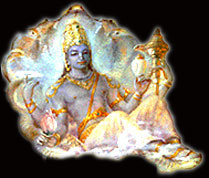Understanding the Three Gunas that Constitute the Mind
Gunas are the qualities that govern our responses and actions in the wordly life. They function on the mental plane as subtle energies. Similar to the doshas that determine our physical constitution, gunas determine our mental constitution.
 The mental gunas Satwa, Rajas and Tamas represent three levels of awakening at the mental level. Ayurveda teaches us that these levels represent direct reflection, state of clarity and understanding.
The mental gunas Satwa, Rajas and Tamas represent three levels of awakening at the mental level. Ayurveda teaches us that these levels represent direct reflection, state of clarity and understanding.
Immediate and subtle causes and effects move between the gunas and consciousness. In psychological and moral dispositions, the gunas provide the basis for the distinctions in human temperament and individual differences.
This is not about good or bad, or between right or wrong. It’s about the uniqueness of one individual from another in how they feel and act towards situations, relationships and events. Gunas have a profound effect on our responses and actions. By observing our gunas we can develop awareness of our mental states and consciousness. Whether we come to an understanding of our gunas through self-reflection, or through the mediation of a spiritual guru or an Ayurvedic healer, it's important to determine our own individual guna qualities of spiritual awakening -- indeed this realization is essential and must occur before healing can happen at any level.
Charaka, the great scholar of Ayurveda, says that the mind of a person is determined on the basis of repeated action due to the predominate guna in the mind. Satwa is like a clear, still pond or a cloudless sky. It is transparency of the mind. A Rajasic mind is like a pond disturbed by a stone and hardly transparent. And the Tamasic mind has the quality of a pond that is opaque, nothing is visible in it and it has its own detritus.
Individuals are a mixture of these gunas in different ratios. As the individual's state of mind keeps changing, so do the qualities of gunas or the actions of each person. All three gunas have importance. It's how we control our gunas that help us reach an optimal state of mind. Sometimes we are Satwic, while at times we display Rajasic or Tamasic qualities. In spite of the ever changing qualities of the mind, there is one and only one quality that is dominant in each person.
 So, if one has a Satwic state of mind most of the time, with an occasional display of Rajas or Tamas, that person will be known as; "one with a Satwic nature." Satwa brings about health and calmness of the mind. In a purely Satwic person, the chance of disease is greatly diminished. These individuals act in harmony with their environment without the wall of ego around them. Their senses are under their control and they are unattached to their perfection. The truth and virtues in the speech and actions of the Satwic-minded person are easily recognized by others.
So, if one has a Satwic state of mind most of the time, with an occasional display of Rajas or Tamas, that person will be known as; "one with a Satwic nature." Satwa brings about health and calmness of the mind. In a purely Satwic person, the chance of disease is greatly diminished. These individuals act in harmony with their environment without the wall of ego around them. Their senses are under their control and they are unattached to their perfection. The truth and virtues in the speech and actions of the Satwic-minded person are easily recognized by others.
Satwic healers emit Satwic vibrations and prana from their bodies and minds that create an incredible healing effect. However, if a negative Tamasic natured individual received vibrations from a Satwic healer, then the vibrations might fail to penetrate. It’s important that every individual try to cultivate the Satwic guna in order to see major changes to their health.
Satwa means purity, understanding at the deeper levels, and well-developed discrimination between wrong and right. It is true wisdom at the spiritual plane and brings about enlightenment. It is true connectedness to the divine.
The Satwic individual is engaged in truthfulness, is not interested in the fruits of their actions, performs selfless service and has the golden quality of universal love. Satwic individuals are calm and light, happy and healthy, in tune with nature and have surrendered to the Lord. Ayurveda recognizes the positive traits of Rajas and Tamas, however it emphasizes a Satwic diet, spiritual practices and a Satwic lifestyle to stay happy in life.
Nature before manifestation is called Avaykta, which means undefined and unmanifested – the state in which these three gunas are held in perfect balance.
In a manifested state, the expression changes and gunas begin to mix and mingle in various ways. The individual’s balance is disturbed, and the result creates the ego and the material world.
When Satwa is predominant there is knowledge. Rajas instills activity, while Tamas instills destruction - both can be used in a positive manner. It is when Rajas and Tamas are out of balance that they are seen as negative qualities to learn to observe and control.
 Rajasic activity is usually for personal gain, it brings short-lived happiness with pain, suffering and disease in the end. The Rajasic individual can transform himself to Satwa by spiritual practices under the guidance of spiritual master, life style adjustments and a deeper understanding of life and its forces.
Rajasic activity is usually for personal gain, it brings short-lived happiness with pain, suffering and disease in the end. The Rajasic individual can transform himself to Satwa by spiritual practices under the guidance of spiritual master, life style adjustments and a deeper understanding of life and its forces.
Darkness, lassitude, idleness, and ignorance leads to distraction and turbulence that creates response challenges and negative emotions that interfere with a divine connection.
Tamas is a total dark and inert quality. It is full of dullness, disease and death.
Tamas is considered dull and heavy. A Tamasic individual does not know the purpose of life. He is lethargic or engaged in wrongful activities and chronically ill.
 The Tamasic mind tends towards perversion. These people inflict pain on themselves in their desire to overcome others, who are living happily.
The Tamasic mind tends towards perversion. These people inflict pain on themselves in their desire to overcome others, who are living happily.
Drug addictions, alcoholism, crime, terrorist activity, rape, and theft are typical Tamasic activities. The Tamasic individual can transform to Rajas through proper guidance and then ultimately to Satwa.
Never relinquish hope! Seek happiness more and more. Observe your gunas and recognize the positive and negative traits. Keep moving towards a Satwic nature by applying the calm, patient and loving traits of Satwa to yourself.
Seek the guidance of a recognized spiritual teacher or Ayurvedic healer for a consultation to determine the state of your own gunas and to help you formulate a program that will enable you to transcend the current limitations of your personality and nature.
Published with the kind permission of Dr. Usha Khosla
* * * * * * * * * * * * * * * * * * * * *
 Usha Khosla, CAS. MD (India), Clinical Ayurveda Specialist
Usha Khosla, CAS. MD (India), Clinical Ayurveda Specialist
Ayurveda Healing Center
Location: Bay Area (Hayward)
Services: Ayurvedic herbs and medicines, diet and nutritional guidance, Pancha Karma, infertility, marma therapy, pranayama
Telephone: (510) 727-9891
Email: ushakhosla@@hotmail.com
Website: http://www.ayurvedahealingcenter.com/
Usha Khosla was born during an auspicious full moon in the valley of Himachal Pardesh, India. This is located in northern India, in the foothills of the Himalayas.
Usha was provided with excellent opportunities for education. She attended the University of Delhi, earning the degree of Bachelor of Medicine and Bachelor of Surgery, which is the qualification for practicing medicine in India. Next, she attended Nagpur University, earning a diploma in Gynecology and Obstetrics. These qualifications are equivalent to a Doctor of Medicine degree in the United States.
Usha started doing research using Ayurvedic medicine in the treatment of infertility. Her positive research results were published in “MEDICINE AND SURGERY” in 1981 "Management of Primary and Secondary Sterility, A Clinical Trial with Aloes Compound (Ayurvedic Herbal Product), D&C, Injection Placentrex, and Combination."
During the 1990's Usha and her family migrated to the United States. Convinced of the profound health benefits available from Ayurveda, she attended the California College of Ayurveda and graduated at the top of her class. Usha has been practicing Ayurveda in California for the past fifteen years. Usha's Ayurvedic training and practical experience combined with her background as a medical doctor makes her uniquely qualified to fulfill her goal of meaningfully contributing towards the health, happiness, and enlightenment of her patients.
